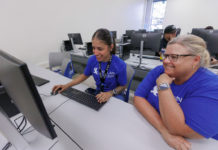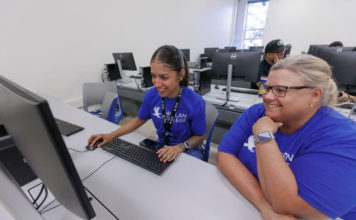
GILROY—Santa Clara University students are hard at work engineering a solar-powered tiny home for an international competition, and they’re getting Gilroy’s help designing the structure that will have a permanent place at a South County nonprofit.
A team of undergraduate engineering students, mainly juniors, are preparing for the 2016 Solar Decathlon in Washington D.C., sponsored by the U.S. Department of Energy. Gilroy contractors Steve Ashford and Bill Cline are offering their expertise and assistance as the team builds a self-contained 256-square-foot tiny home—complete with a toilet that doesn’t require plumbing and a machine that actually pumps out water.
The goal is to design, build and rigorously test a home that uses as little resources as possible and win the competition, comprised of 20 teams. This one is 8 feet by 32 feet.
During the contest, which takes place in October 2016, each home and its solar panels will be tested on how it performs for tasks like charging a cell phone and producing enough hot water for a shower.
The concept of tiny homes has been catching on nationally, and local service organizations are considering them as a solution to homelessness. The Gilroy Compassion Center is currently pursuing a proposal at the county level to build a village of tiny homes to house South County’s homeless.
The student team is “ignited by a reaffirmed passion for engineering,” said SCU junior and team member Marcus Grassi.
Entries in the Solar Decathlon must cost only $25,000, including the materials used to build it, and have a net zero energy usage, according to the team. After the competition, the home will travel from the National Mall in Washington D.C. to San Martin-based nonprofit Operation Freedom Paws where it will have a permanent space.
Operation Freedom Paws seeks to empower veterans and others with disabilities—and improve their quality of life—by teaching them to train their own dogs through a no-cost 48-week training program that can ultimately certify them as service dogs, according to its website. Those dogs then help clients feel safe, secure and even assist with day-to-day activities.
Most canines there are rescued from shelters, and after each dog is evaluated it’s matched to a client based on his or her physical and psychological needs.
“When they asked where this [home] would go, that was the first thing that came to my mind. We left it up to the kids and they took a field trip,” Ashford said. “I think the rest is history.”
Junior engineering student and team member JJ Galvin said after meeting with the nonprofit’s team in San Martin, “It’s hard to say no. You don’t want to say no. With such a new, cool house we’re trying to build and their great idea over there, it’s beneficial not just for the competition but for them, too.”
Galvin and the undergraduate team are currently selecting specific materials to incorporate into the design and hashing out its specifications. One of the materials is produced by Gilroy-based Metacrylics and they’ve offered to donate product for the students and have an installer come by and train them how to do it properly.
Over the summer, the team designed the water system and they will be expanding it to increase how much water it produces.
The students make all the decisions and design everything themselves, Ashford said.
“We’re just pointing them in the right direction,” the contractor said, now helping SCU with the Solar Decathlon in his fourth year.
They will piece the structure together in the spring. In the meantime, team members said they have their work cut out for them.
Galvin, who returned last month from a mission trip in Rwanda with Engineers Without Borders, said the visit opened his eyes to how engineering skills and some creative thinking can solve a range of problems. He built a tile press powered by a bicycle to fill the village’s greatest need—more housing tiles to protect from the elements.
“There’s so much we can do to help,” he said. “Even a small house can be a huge help. It’s not just for the Silicon Valley; it’s the basics.”
Working with the students has been rewarding for Ashford. As a contractor, he said he works with a lot of engineers but keeps coming back to help students, who he affectionately calls the “kids,” with another Solar Decathlon.
“It’s rare to find such hard workers. It’s great experience and well worth the effort,” he said, adding the team of undergraduates knows how to work with their hands better than some professionals.
The SCU team will be going toe-to-toe with 20 other teams from around the world—mostly comprised of graduate students, according to university officials. Germany, for example, has already patented the technology they used in past competitions, Galvin pointed out.
But rather than build the home and sell it to the highest bidder, or a venture capital firm, Galvin and Grassi said the goal is to prove a point.
“You can be off the grid anywhere in one of these. They will work where you have a water tank, so while water is a really limiting factor, it’s completely self sustaining,” Galvin said. “Finding homes is not as easy as it sounds.”














